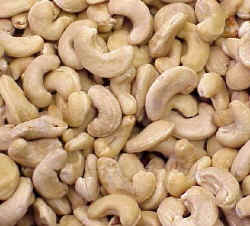 The cashew, Anacardium occidentale L. , belongs to the Anacardiaceae or cashew family. Two related plants in this family are the mango tree and pistachio tree. The cashew, Anacardium occidentale L. , belongs to the Anacardiaceae or cashew family. Two related plants in this family are the mango tree and pistachio tree.
The delightful cashew nut is loved by everybody. Cashews are a product loved by the wealthy nations and provided for by the poor nations. Cashews are found growing on cashew trees or "bushes" near the equator. The cashew grows wild in Brazil and in cashew plantations in India where the cashew was transplanted into a cashew crop.
The cashew tree is native to South America where it flourishes in Brazil and Peru .
The first western people sighting the cashew tree was by the Portuguese.
They invaded Brazil in the 1500's. Portuguese seamen brought the seeds of the cashew nut tree from Brazil to be planted by the early settlers along the east coast of Africa . The trees took root and thrived. It was not long before cashew trees were growing wild along the entire coast of Mozambique . They spread to Kenya and Tanzania .
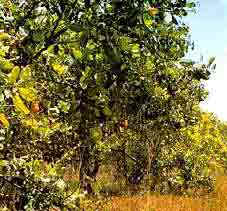 Uncared for and uncultivated, the ripe nuts were primarily harvested by the African natives. Later, they were sold to the Portuguese traders who in turn disposed of them to merchants who then shipped the nuts to India where they were shelled. Uncared for and uncultivated, the ripe nuts were primarily harvested by the African natives. Later, they were sold to the Portuguese traders who in turn disposed of them to merchants who then shipped the nuts to India where they were shelled.
In the sixteenth century, Portuguese traders introduced the tree to India where it has more recently become an important export crop equal to that of Brazil .
Eventually, India grew their own cashew tree and the Kerala State ( India ) Cashew Association is now the largest exporter of cashews in the world.
Forteleza , Brazil , ships the second largest quantity of cashews and the two areas represent over 80 percent of the world supply which is around 4 million cases (50 pounds per case). Africa is a distant third. The India crop harvests in May and the Brazilian crop harvests in October.
Other countries that grow and export cashews include Sri Lanka , China , Malaysia , the Philippines , Thailand , Colombia , Guatemala , Venezuela , the West Indies, Nigeria , Mozambique , Tanzania , and Kenya .
The United States is the largest importer of cashew nuts.
The cashew tree is a hearty, fast-growing evergreen with an umbrella-like canopy. Under favorable conditions it may reach a height of forty to fifty feet.
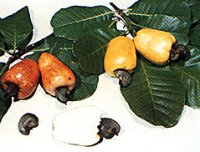 The tree has a rather messy look with it's gnarled stem and crooked branches. Lower branches rest near the ground and may root further augmenting it's spreading form. The leaves of the cashew tree are four to eight inches long and two to three inches wide. Its aromatic flower clusters are a yellowish pink. The tree has a rather messy look with it's gnarled stem and crooked branches. Lower branches rest near the ground and may root further augmenting it's spreading form. The leaves of the cashew tree are four to eight inches long and two to three inches wide. Its aromatic flower clusters are a yellowish pink.
Cashew trees produce both a fruit ("apple") and a nut, and a valuable oil can be drawn from the nut shell. After the cashew flower blooms, a nut forms.
The apple later swells between the nut shell and the stem.
It takes two months for the cashew apple to ripen.
When harvested, the apple can only keep for twenty-four hours before it begins to ferment. Although the fruit can be used for making many typical fruit products (jellies, jams, juice, wine and liquor), the apple is often discarded, in pursuit of the nut.
If processed and stored properly, the cashew nut can be kept for a year or longer.
Technically, the actual nut is the thick-shelled seed.
The outer shell (coat) of the seed contains the poison oak allergen urushiol, and may cause dermatitis in hypersensitive people.
There is a toxic resin inside the shell layer. If the shell is not opened properly, the resin will get on the cashew nut, making it inedible. Most companies steam the shell open at a high temperature, thus cooking the cashew nut inside.
A certain nut producer in Indonesia uses a special technique with specially-designed tools (without using any heat at all) to open the shell cleanly every time without ever exposing the cashew nut to the resin.
The raw cashews are much sweeter, tastier, and nutritious than their cooked counterparts.
Many people avoid cashew nuts because of their high fat content, though they are lower in total fat than almonds, peanuts, pecans, and walnuts.
Cashew provide essential fatty acids, B vitamins, fiber, protein, carbohydrate potassium, iron, and zinc. Like other nuts, cashews are high in saturated fat; however, eaten in small quantities cashews are a highly nutritious food.
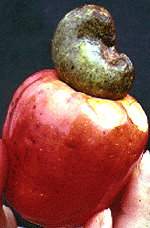 GRADING GRADING
Cracking open the shell results in many broken kernels which bring a lower market price. Cashews are graded on how white they are and how broken the kernel is.
There are four color grades, four styles of break on the kernel and six sizes (or maximum number of kernels per pound).
1 Is the whitest kernel and the best
2 Is lightly scorched
3 Is scorched and dark
4 Is extremely dark and not in much demand
Purchasing Houses buy many grades and sizes because customers have different needs. That's why the price varies as the nuts get larger and whiter.
Whole sizes cost more than pieces.
Most Purchasing Houses buy the top grades of cashews - only the whitest and highest quality.
HOW ARE CASHEW NUTS PROCESSED?
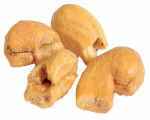 At the factory, the cashew kernels are roasted at 325 degrees Fahrenheit in hot roasting oil for between 5 and 12 minutes. This softens the kernel and gives it a buttery taste. No two batches of cashews roast the same, so it requires skill and careful watching of the exact moment when the nut starts to turn an ivory color. Only by roasting in small batches can we get the perfect roast on each nut. At the factory, the cashew kernels are roasted at 325 degrees Fahrenheit in hot roasting oil for between 5 and 12 minutes. This softens the kernel and gives it a buttery taste. No two batches of cashews roast the same, so it requires skill and careful watching of the exact moment when the nut starts to turn an ivory color. Only by roasting in small batches can we get the perfect roast on each nut.
As the nut starts to go from the white stage to a light ivory color, the nut is removed, the kernels drained and let to cool on stainless steel tables that hold 250 pounds. As they cool, they become crunchy and sweet, and they slowly turn a rich light brown color. At this stage, salt is added to the nuts while they are still warm to get the maximum rich taste. Some of the roasted nuts are set aside for unsalted uses.
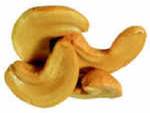 Purchasing/Roasting Houses receive cashews from many countries and each lot is different. Purchasing/Roasting Houses receive cashews from many countries and each lot is different.
The Brazilian cashew is the largest, softest and whitest cashew. Some find them sweeter or richer in taste. Health food stores love large, white Brazilian cashews.
Cashews from India are smaller and much more crisp. They can be sweet, but they can be bland. Indian cashews are more ivory in color. In more recent years, Purchasing/Roasting Houses have received cashews from China and recently from Vietnam . Vietnam cashew pieces are extremely sweet.
Purchasing/Roasting Houses love the largeness of the Brazilian cashew because customers love large sizes.
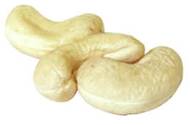 Purchasing/Roasting Houses also love the crispness found in the Indian, African and Vietnamese cashews, even if they are smaller sizes. Purchasing/Roasting Houses also love the crispness found in the Indian, African and Vietnamese cashews, even if they are smaller sizes.
Often, Purchasing/Roasting Houses have cashews in their plants from all five growing areas at the same time. Purchasing/Roasting Houses know each shipper's label and their special taste - much like a coffee or wine expert.
It is not uncommon for Purchasing/Roasting Houses to go easily through 50,000 to 100,000 pounds of cashews in a year.
Click here to fill out the Online Request Form |